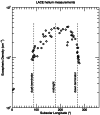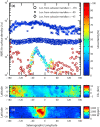Volatiles and Refractories in Surface-Bounded Exospheres in the Inner Solar System
- PMID: 34720217
- PMCID: PMC8550778
- DOI: 10.1007/s11214-021-00833-8
Volatiles and Refractories in Surface-Bounded Exospheres in the Inner Solar System
Abstract
Volatiles and refractories represent the two end-members in the volatility range of species in any surface-bounded exosphere. Volatiles include elements that do not interact strongly with the surface, such as neon (detected on the Moon) and helium (detected both on the Moon and at Mercury), but also argon, a noble gas (detected on the Moon) that surprisingly adsorbs at the cold lunar nighttime surface. Refractories include species such as calcium, magnesium, iron, and aluminum, all of which have very strong bonds with the lunar surface and thus need energetic processes to be ejected into the exosphere. Here we focus on the properties of species that have been detected in the exospheres of inner Solar System bodies, specifically the Moon and Mercury, and how they provide important information to understand source and loss processes of these exospheres, as well as their dependence on variations in external drivers.
Keywords: Exosphere; Ions; Magnetosphere; Mercury; Moon; Neutrals; Refractories; Solar wind; Volatiles.
© The Author(s) 2021.
Figures

















References
-
- A’Hearn M.F., Feldman P.D. Water vaporization on Ceres. Icarus. 1992;98(1):54–60. doi: 10.1016/0019-1035(92)90206-M. - DOI
-
- Altwegg K., Balsiger H., Calmonte U., Hässig M., Hofer L., Jäckel A., et al. In situ mass spectrometry during the Lutetia flyby. Planet. Space Sci. 2012;66(1):173–178. doi: 10.1016/j.pss.2011.08.011. - DOI
-
- Andrews G.B., et al. The energetic particle and plasma spectrometer instrument on the MESSENGER spacecraft. Space Sci. Rev. 2007;131:523–556. doi: 10.1007/s11214-007-9272-5. - DOI
-
- Angelopoulos V. The ARTEMIS mission. Space Sci. Rev. 2011;165(1–4):3–25. doi: 10.1007/s11214-010-9687-2. - DOI
-
- Arnold J.R. Ice in the lunar polar regions. J. Geophys. Res., Solid Earth (1978–2012) 1979;84(B10):5659–5668. doi: 10.1029/JB084iB10p05659. - DOI
Publication types
LinkOut - more resources
Full Text Sources
